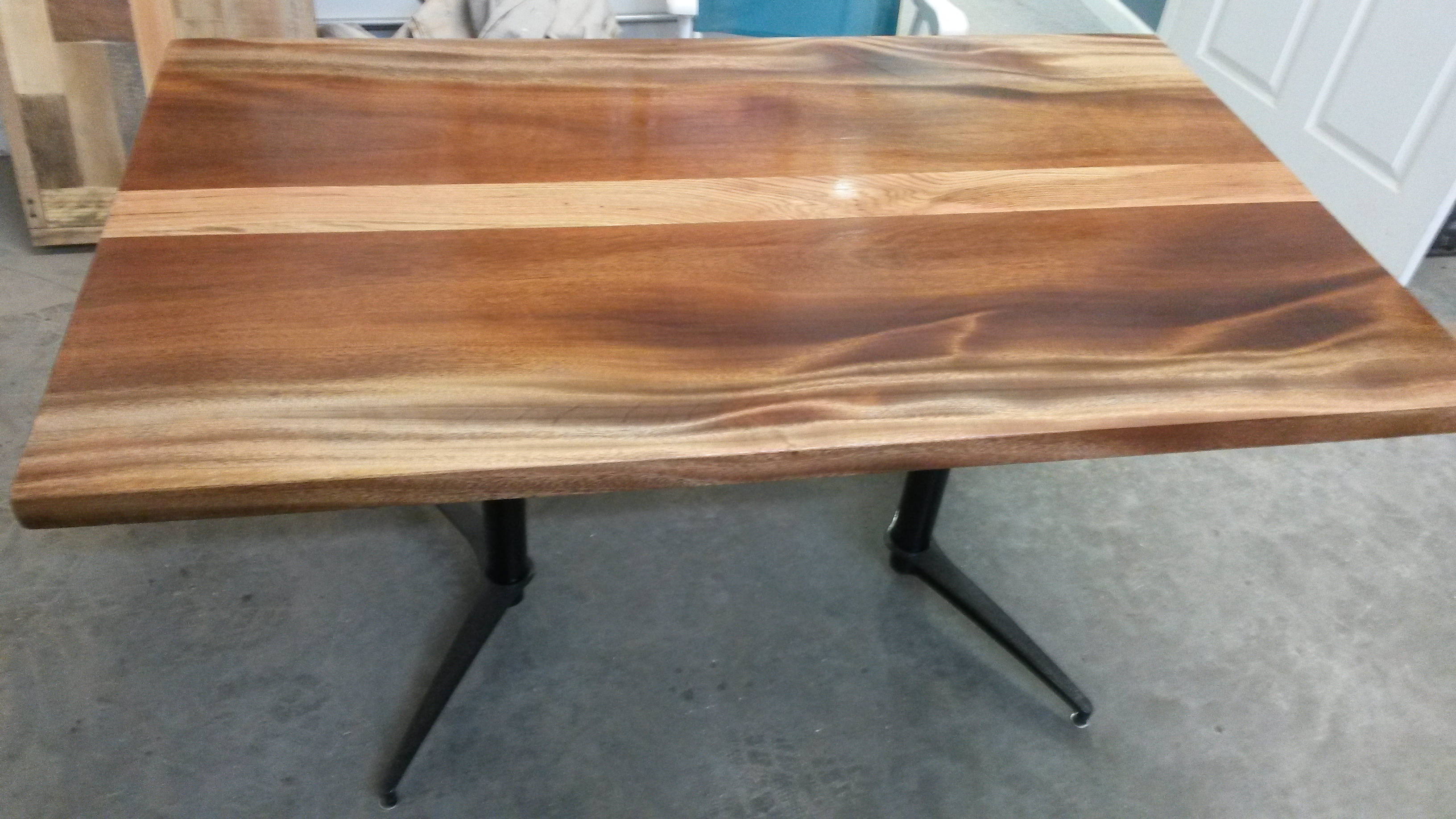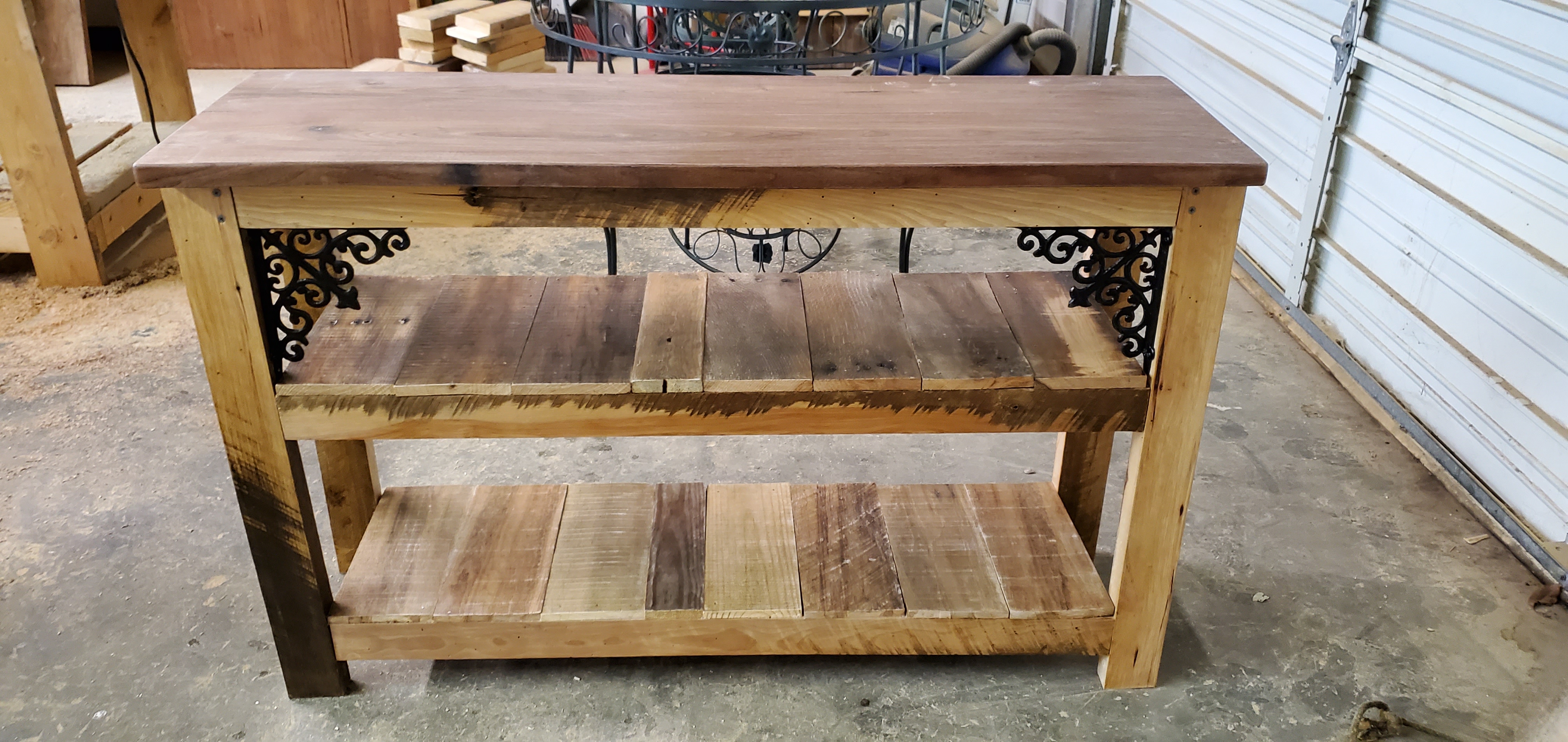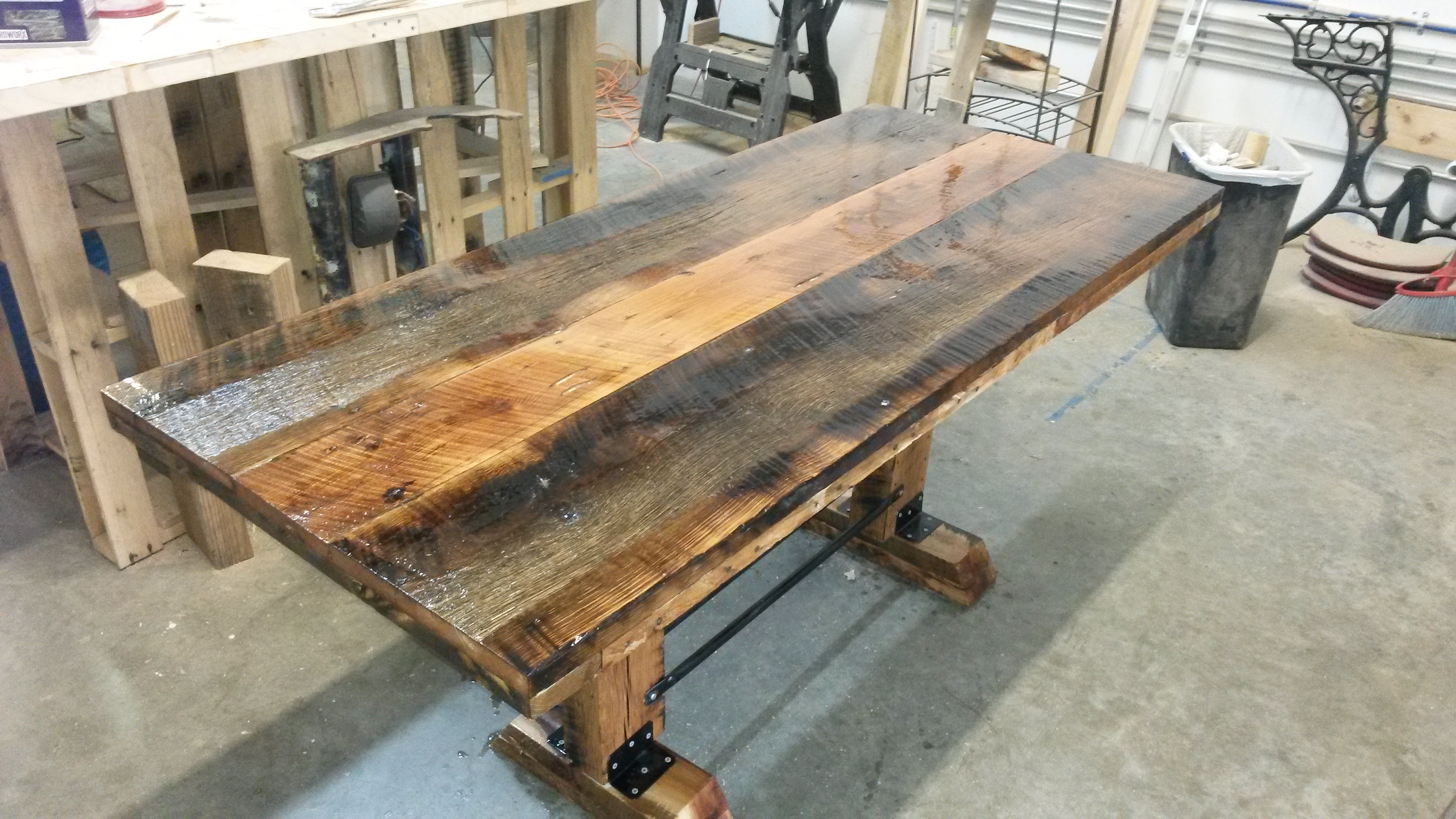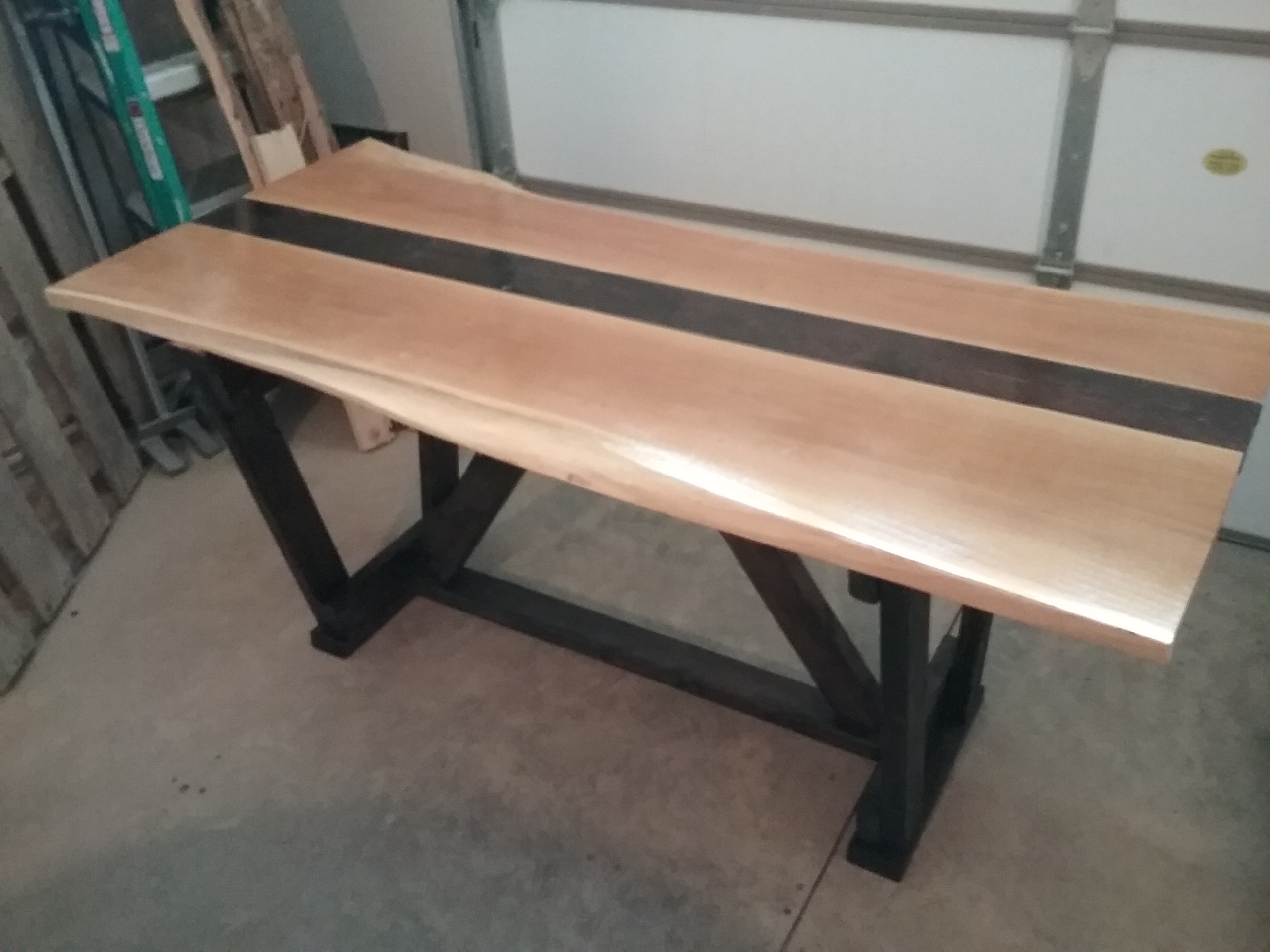Vita Nova - Mills River, NC
 I call this RUSTIC LEVEL 1 - not really rustic at all.
This is probably THE most finished table I have ever made. A lady in Swannanoa had a 10-foot mahogany slab that was left to her by a cabinet maker
who had left the state. After I cut it in half and joined it with some white oak for contrast, I realized the wood was just too unusual and
perfect to leave it in any unfinished condition. So I put in LOTS of time sanding and finishing the top. Mahogany is usually a very flat brown wood
without alot of grain, so I was surprised to see the fudge ripple look in this piece. With four chairs, this sold for $1,100. I can make pieces
like this if I find perfect wood, but that is rare.
I call this RUSTIC LEVEL 1 - not really rustic at all.
This is probably THE most finished table I have ever made. A lady in Swannanoa had a 10-foot mahogany slab that was left to her by a cabinet maker
who had left the state. After I cut it in half and joined it with some white oak for contrast, I realized the wood was just too unusual and
perfect to leave it in any unfinished condition. So I put in LOTS of time sanding and finishing the top. Mahogany is usually a very flat brown wood
without alot of grain, so I was surprised to see the fudge ripple look in this piece. With four chairs, this sold for $1,100. I can make pieces
like this if I find perfect wood, but that is rare.
 I call this RUSTIC LEVEL 2 - just enough of a
rustic look to let you know it's repurposed. The top is made of walnut and is highly polished and finished. The legs and skirts are made of
some red that oak I pulled off a horse-feeding shed in South Asheville. The oak had such patina to it that I decided to leave some of it. You can
see the saw marks on one of the legs quite plainly. Then I used pallet wood for the shelves, but added some decorative black brackets to
finish the look. This piece is a good example of rustic plus finished wood and metal.
I call this RUSTIC LEVEL 2 - just enough of a
rustic look to let you know it's repurposed. The top is made of walnut and is highly polished and finished. The legs and skirts are made of
some red that oak I pulled off a horse-feeding shed in South Asheville. The oak had such patina to it that I decided to leave some of it. You can
see the saw marks on one of the legs quite plainly. Then I used pallet wood for the shelves, but added some decorative black brackets to
finish the look. This piece is a good example of rustic plus finished wood and metal.
 I call this RUSTIC LEVEL 3 - VERY RUSTIC
in every way. I acquired some oak barn wood from a salvage store in Asheville. The wood was unusual in that while on the barn, some of it had been
covered by pine planking, which left a smooth black patina on the oak. Other portions of the oak had been in direct sun and were wrinkled like a prune.
When I planed them down, the oak planks looked like two different boards. So I used them for the outside edges of the table and added some wormy
chestnut for the middle. I also used some discarded DirectTV brackets on the legs, which are made of old hemlock beams. This is a real
moose of a table, made with several different repurposed woods and metal. This is about as rustic as it gets.
I call this RUSTIC LEVEL 3 - VERY RUSTIC
in every way. I acquired some oak barn wood from a salvage store in Asheville. The wood was unusual in that while on the barn, some of it had been
covered by pine planking, which left a smooth black patina on the oak. Other portions of the oak had been in direct sun and were wrinkled like a prune.
When I planed them down, the oak planks looked like two different boards. So I used them for the outside edges of the table and added some wormy
chestnut for the middle. I also used some discarded DirectTV brackets on the legs, which are made of old hemlock beams. This is a real
moose of a table, made with several different repurposed woods and metal. This is about as rustic as it gets.
 I also need to describe the LIVE EDGE options.
The term LIVE EDGE can mean different things. It's really just an unfinished piece of wood that came out of the wood milling process with one or both
edges unmilled, usually right where the bark was. So it may have the curved edge of the tree bark and may even have some residual bark on it. You can also
obtain live edge slabs from various sawmills in the Western NC area. This type of wood has not been through the normal wood milling process, it is frequently cut directly from a
log by a slab saw with no attempt to remove the bark. I ALWAYS remove the bark from a live edge because if I didn't, it could break off later on.
This table is made from two slabs of black locust, a hardwood native to the American Southeast (North and South Carolina and Georgia), with a piece of
pine sandwiched in the middle. I sanded the live edge real smooth on this one to highlight the clear golden color of the wood. It was puchased by a college kid
who took it out to Colorado for his dorm.
I also need to describe the LIVE EDGE options.
The term LIVE EDGE can mean different things. It's really just an unfinished piece of wood that came out of the wood milling process with one or both
edges unmilled, usually right where the bark was. So it may have the curved edge of the tree bark and may even have some residual bark on it. You can also
obtain live edge slabs from various sawmills in the Western NC area. This type of wood has not been through the normal wood milling process, it is frequently cut directly from a
log by a slab saw with no attempt to remove the bark. I ALWAYS remove the bark from a live edge because if I didn't, it could break off later on.
This table is made from two slabs of black locust, a hardwood native to the American Southeast (North and South Carolina and Georgia), with a piece of
pine sandwiched in the middle. I sanded the live edge real smooth on this one to highlight the clear golden color of the wood. It was puchased by a college kid
who took it out to Colorado for his dorm.
 I call this RUSTIC LEVEL 1 - not really rustic at all.
This is probably THE most finished table I have ever made. A lady in Swannanoa had a 10-foot mahogany slab that was left to her by a cabinet maker
who had left the state. After I cut it in half and joined it with some white oak for contrast, I realized the wood was just too unusual and
perfect to leave it in any unfinished condition. So I put in LOTS of time sanding and finishing the top. Mahogany is usually a very flat brown wood
without alot of grain, so I was surprised to see the fudge ripple look in this piece. With four chairs, this sold for $1,100. I can make pieces
like this if I find perfect wood, but that is rare.
I call this RUSTIC LEVEL 1 - not really rustic at all.
This is probably THE most finished table I have ever made. A lady in Swannanoa had a 10-foot mahogany slab that was left to her by a cabinet maker
who had left the state. After I cut it in half and joined it with some white oak for contrast, I realized the wood was just too unusual and
perfect to leave it in any unfinished condition. So I put in LOTS of time sanding and finishing the top. Mahogany is usually a very flat brown wood
without alot of grain, so I was surprised to see the fudge ripple look in this piece. With four chairs, this sold for $1,100. I can make pieces
like this if I find perfect wood, but that is rare.  I call this RUSTIC LEVEL 2 - just enough of a
rustic look to let you know it's repurposed. The top is made of walnut and is highly polished and finished. The legs and skirts are made of
some red that oak I pulled off a horse-feeding shed in South Asheville. The oak had such patina to it that I decided to leave some of it. You can
see the saw marks on one of the legs quite plainly. Then I used pallet wood for the shelves, but added some decorative black brackets to
finish the look. This piece is a good example of rustic plus finished wood and metal.
I call this RUSTIC LEVEL 2 - just enough of a
rustic look to let you know it's repurposed. The top is made of walnut and is highly polished and finished. The legs and skirts are made of
some red that oak I pulled off a horse-feeding shed in South Asheville. The oak had such patina to it that I decided to leave some of it. You can
see the saw marks on one of the legs quite plainly. Then I used pallet wood for the shelves, but added some decorative black brackets to
finish the look. This piece is a good example of rustic plus finished wood and metal.  I call this RUSTIC LEVEL 3 - VERY RUSTIC
in every way. I acquired some oak barn wood from a salvage store in Asheville. The wood was unusual in that while on the barn, some of it had been
covered by pine planking, which left a smooth black patina on the oak. Other portions of the oak had been in direct sun and were wrinkled like a prune.
When I planed them down, the oak planks looked like two different boards. So I used them for the outside edges of the table and added some wormy
chestnut for the middle. I also used some discarded DirectTV brackets on the legs, which are made of old hemlock beams. This is a real
moose of a table, made with several different repurposed woods and metal. This is about as rustic as it gets.
I call this RUSTIC LEVEL 3 - VERY RUSTIC
in every way. I acquired some oak barn wood from a salvage store in Asheville. The wood was unusual in that while on the barn, some of it had been
covered by pine planking, which left a smooth black patina on the oak. Other portions of the oak had been in direct sun and were wrinkled like a prune.
When I planed them down, the oak planks looked like two different boards. So I used them for the outside edges of the table and added some wormy
chestnut for the middle. I also used some discarded DirectTV brackets on the legs, which are made of old hemlock beams. This is a real
moose of a table, made with several different repurposed woods and metal. This is about as rustic as it gets. I also need to describe the LIVE EDGE options.
The term LIVE EDGE can mean different things. It's really just an unfinished piece of wood that came out of the wood milling process with one or both
edges unmilled, usually right where the bark was. So it may have the curved edge of the tree bark and may even have some residual bark on it. You can also
obtain live edge slabs from various sawmills in the Western NC area. This type of wood has not been through the normal wood milling process, it is frequently cut directly from a
log by a slab saw with no attempt to remove the bark. I ALWAYS remove the bark from a live edge because if I didn't, it could break off later on.
This table is made from two slabs of black locust, a hardwood native to the American Southeast (North and South Carolina and Georgia), with a piece of
pine sandwiched in the middle. I sanded the live edge real smooth on this one to highlight the clear golden color of the wood. It was puchased by a college kid
who took it out to Colorado for his dorm.
I also need to describe the LIVE EDGE options.
The term LIVE EDGE can mean different things. It's really just an unfinished piece of wood that came out of the wood milling process with one or both
edges unmilled, usually right where the bark was. So it may have the curved edge of the tree bark and may even have some residual bark on it. You can also
obtain live edge slabs from various sawmills in the Western NC area. This type of wood has not been through the normal wood milling process, it is frequently cut directly from a
log by a slab saw with no attempt to remove the bark. I ALWAYS remove the bark from a live edge because if I didn't, it could break off later on.
This table is made from two slabs of black locust, a hardwood native to the American Southeast (North and South Carolina and Georgia), with a piece of
pine sandwiched in the middle. I sanded the live edge real smooth on this one to highlight the clear golden color of the wood. It was puchased by a college kid
who took it out to Colorado for his dorm.